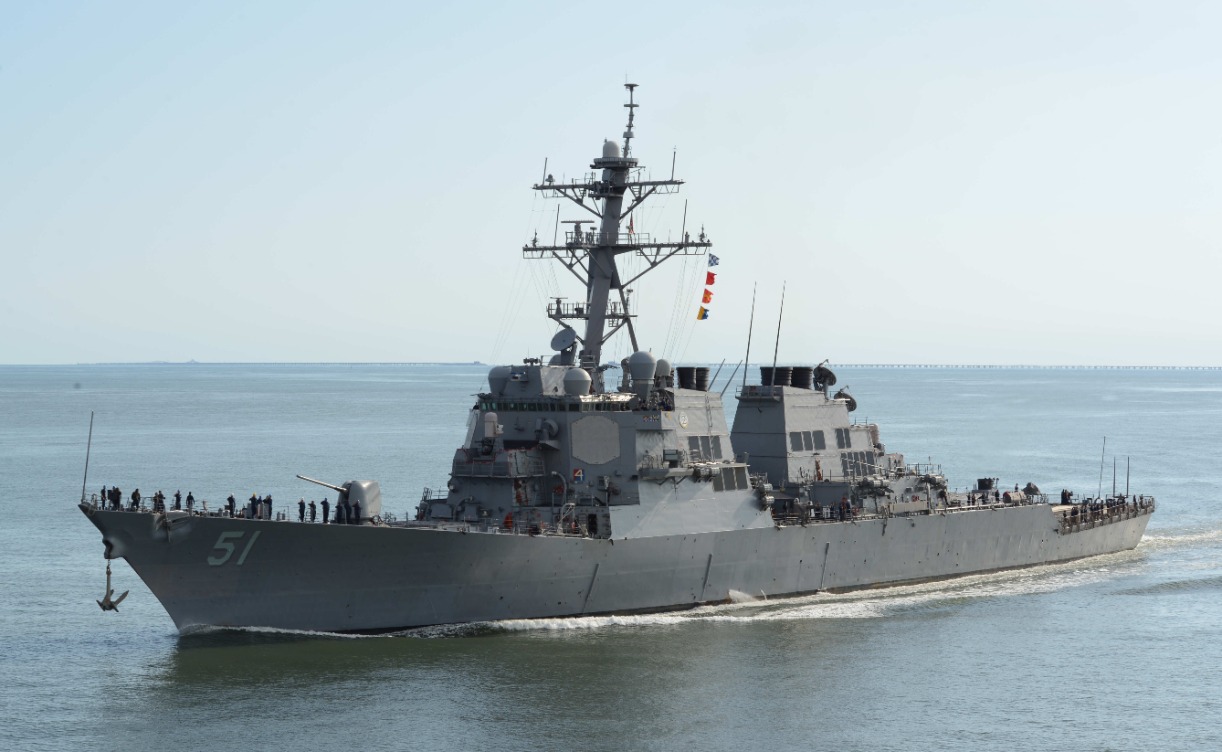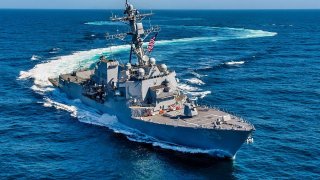The Navy's Arleigh Burke Block III Class: Oozing with Firepower
The U.S. Navy's latest iteration of the Arleigh Burke-class destroyers, known as Block III, has recently gained attention with new images showcasing the Surface Electronic Warfare Improvement Program (SEWIP) Block III system.
Summary and Key Points: The U.S. Navy's latest iteration of the Arleigh Burke-class destroyers, known as Block III, has recently gained attention with new images showcasing the Surface Electronic Warfare Improvement Program (SEWIP) Block III system.

-This version features a distinctive "muffin top" midsection designed to accommodate future upgrades, emphasizing the Navy's commitment to enhancing electronic warfare capabilities amidst rising tensions with China and Russia.
-These destroyers, equipped with advanced radar systems and formidable weaponry, are crucial for maintaining U.S. naval dominance. Each Block III ship, estimated at $2 billion, represents a significant investment in modernizing the fleet.
Meet the Arleigh Burke Block III: The U.S. Navy’s Next-Gen Destroyer
In November of last year, new images of the U.S. Navy’s latest Arleigh Burke-class iteration circulated in the military news realm.
Pictures of the service’s cutting-edge Surface Electronic Warfare Improvement Program (SEWIP) Block III installation were published for the first time aboard one of these destroyers.
The new system makes the Arliegh Burke Class Block III ship look very different from its predecessors. Specifically, the new destroyer features a large, bulging middle frame that some have dubbed “the muffin top.”
The Navy’s latest destroyer class is being constructed amidst rising tensions between Washington and Beijing.
As stated by GlobalData Defense analyst James Marques, “It’s right to say that the US is contemplating force size – and maintaining a larger fleet of Arleigh Burke ships is part of the answer.”
A Brief History of the Arleigh Burke-class
Named to honor World War II American destroyer officer Admiral Arleigh Burke, this class of guided-missile destroyers are larger and more heavily armed than their predecessors. The class’ design was derived in part following lessons learned by the Royal Navy during the Falklands campaign.

Additionally, the Navy built on the existing Ticonderoga-class guided-missile cruisers, which were highly pricey and challenging to maintain. With these two notions in mind, engineers constructed a modern destroyer with capabilities to lower its radar cross-section, among other enhancements.
A smaller cross-section makes it more difficult for enemy warships to detect, a critical asset for the Navy. The Arleigh Burke-clas ships were also equipped with a Collective Protection System which enables her to function in conditions contaminated by radiological, chemical or biological materials.
In terms of sensor system, a slightly downgraded variant of the Aegis Combat System was incorporated into the ships, allowing them to launch, track, and evade missiles at the same time.
Specs & Capabilities
The USS Arleigh Burke was commissioned back in 1991, after several years of testing. From combat system to propulsion plant testing, the destroyer underwent thorough examinations prior to launching. Similar to other modern American surface combatants, DDG 51 uses gas turbine propulsion. Each Arleigh Burke ship is equipped with four General Electric LM 2500 gas turbines to produce 100,000 total shaft horsepower by a dual shaft design.
This enables the class of destroyers to sail at speeds reaching 30+ knots in the ocean. In terms of weapons, these destroyers are quite formidable. Each ship is armed with 56 Raytheon Tomahawk cruise missiles and a combination of land-attack missiles, anti-ship missiles, and a Tercom-aided navigation system. Both types of missiles are launched from a pair of Lockheed Martin MK41 vertical launch systems.
Over the years, several enhancements were incorporated into the destroyers. In the early 2000s, Raytheon commenced deliveries of the Standard MissileSM-3, which has a kinetic warhead and is constructed for deployment against both short-range and medium-range ballistic missiles.
As detailed by Naval Technology, “The SM-3 will be upgraded to SM-3 Block IIA and SM-3 Block IIB. USS John Finn launched an SM-3 Block IIA missile to intercept and destroy the target successfully during a flight test off the coast of Hawaii in October 2018.” Arleigh Burke ships are also fitted with the Sea Sparrow missile and eight Boeing Harpoon surface-to-surface missiles, among other enhancements.
Arleigh Burke Class Block III:
Last December, the first Flight III Arleigh Burke went underway for the first time to undergo builder’s trials in the Gulf of Mexico. This destroyer class is the first to possess an active electronically scanned array AN/SPY-6 Air and Missile Defense Radar.
Additionally, the latest Block III iteration uniquely includes three Rolls Royce 3-megawatt generators on the Flight 11A ships with Royce’s 4-megawatt generators. The DDG 51 class program manager for Program Executive Office Ships reiterated that “As the first Flight III ship, DDG-125 is the culmination of years of dedication and perseverance to design, build and integrate the Flight III capability of [Aegis Combat System Baseline 10], [SPY-6 Air and Missile Defense Radar] and the supporting systems such as the new electric plant and associated upgrade to the machinery control system.”

Block III’s bulky midsection was in part designed so that future upgrades could be incorporated into the destroyers. Electronic attack capabilities are critical as non-state actors and rogue entities across the seas are possessing more and more capable unmanned aerial vehicles (UAVs), anti-ship cruise missiles and even ballistic missiles. China and Russia are also rushing to secure more sophisticated electronic warfare capabilities as geopolitical tensions ramp up.
Each Arleigh Burke Block III Class variant is estimated to cost around $2 billion, including the Navy providing around $1 billion of equipment for each ship. While this cost may seem high, the rapid introduction of these advanced destroyers to service will be essential for America’s prowess in the seas.
About the Author: Maya Carlin
Maya Carlin, National Security Writer with The National Interest, is an analyst with the Center for Security Policy and a former Anna Sobol Levy Fellow at IDC Herzliya in Israel. She has by-lines in many publications, including The National Interest, Jerusalem Post, and Times of Israel. You can follow her on Twitter: @MayaCarlin.
All images are Creative Commons and or Shutterstock.


